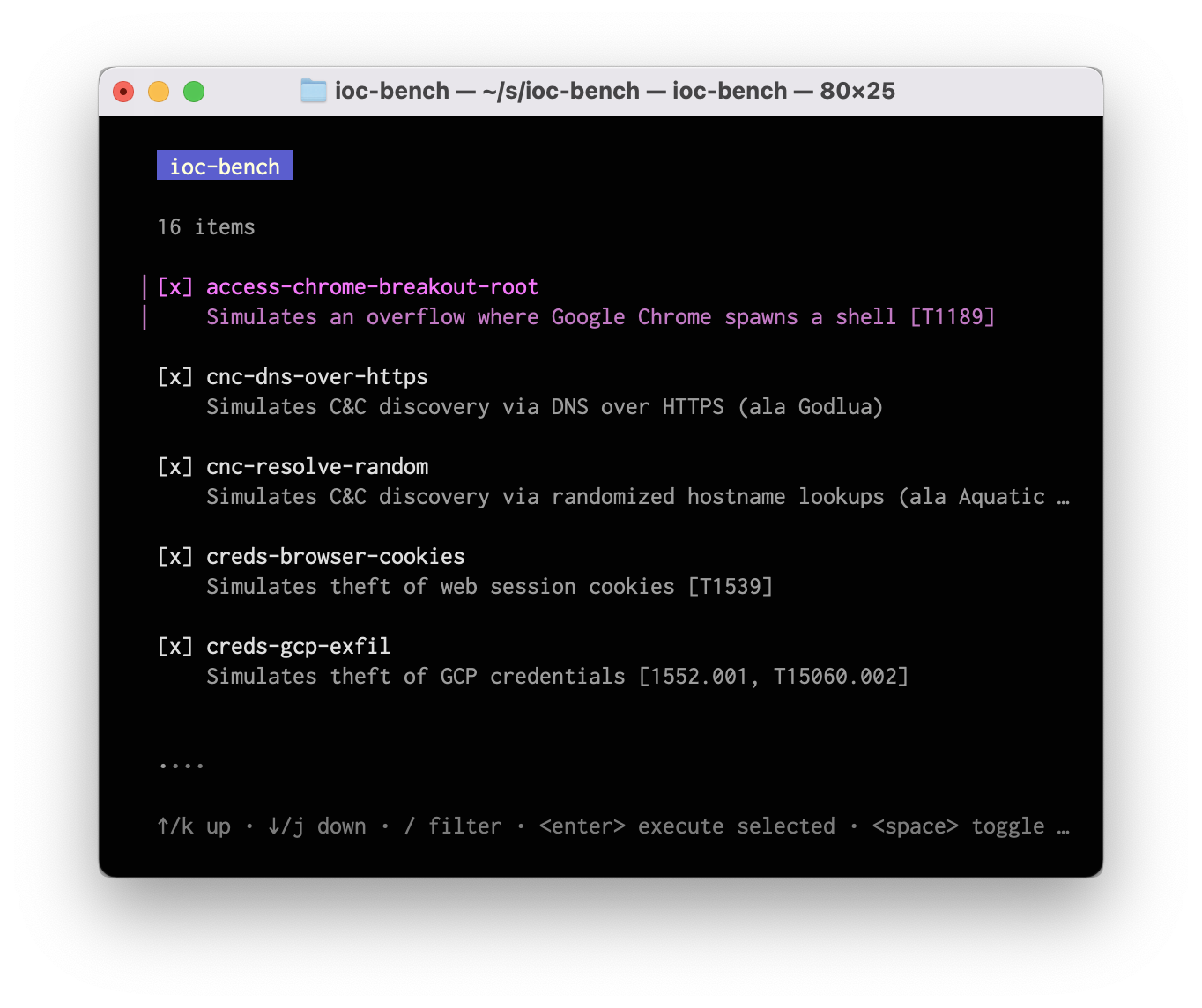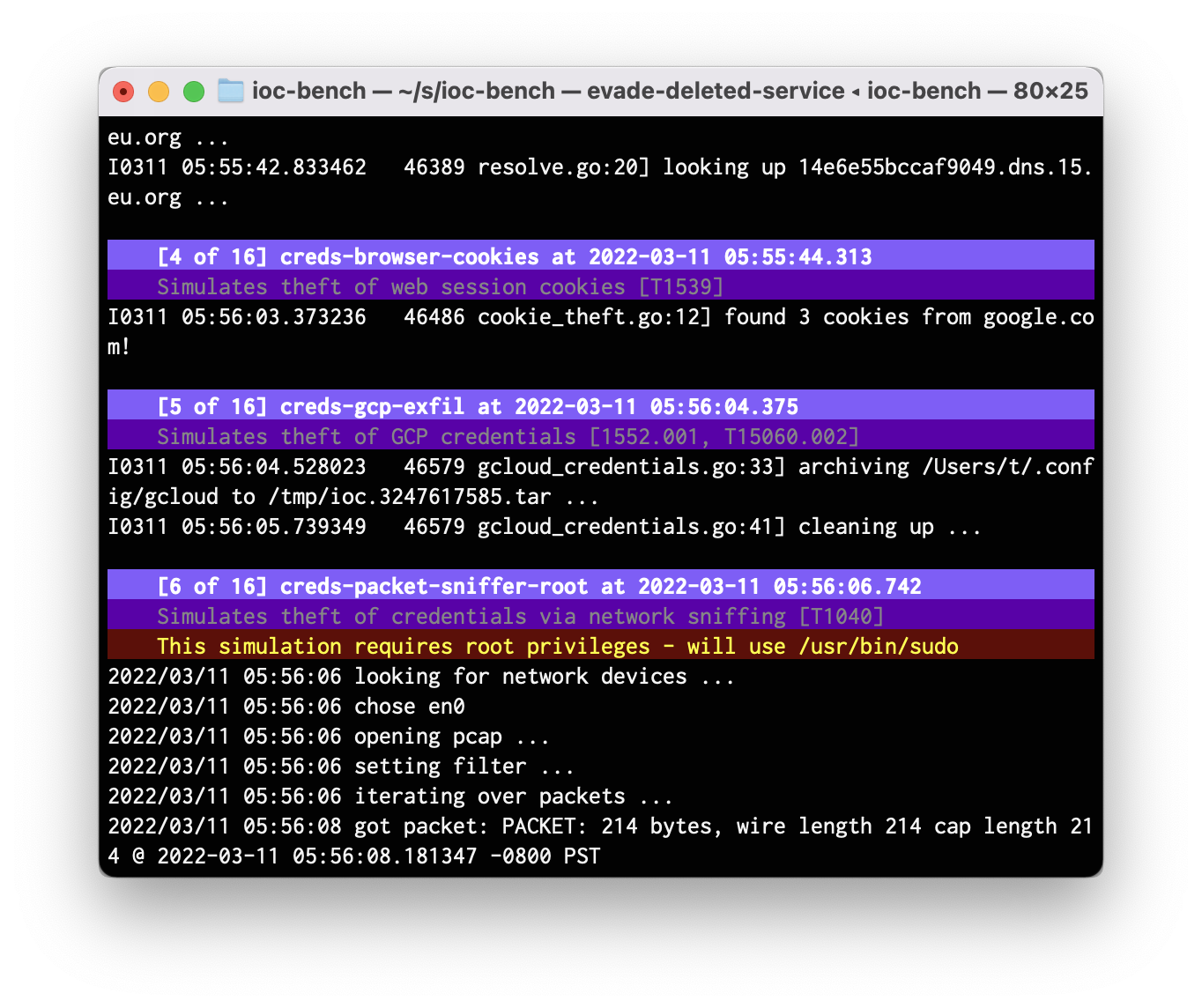ioc-bench
ioc-bench simulates ~24 popular indicators of compromise (IoC) from both the MITRE ATT&CK framework and recently published defense research. All of the simulations behave at least vaguely suspicious, such as stealing GCP credentials, sniffing your keyboard, accessing unusual DNS servers, or pretending to be a kernel process.
How many of these simulations does your intrusion detection configuration detect?
Screenshots
Requirements
- The Go Programming language
Most of the checks available today mimic IoC found on UNIX-like operating systems. This is however not an intentional design goal. ioc-bench is actively tested on Linux, macOS, and FreeBSD.
Usage
To jump in, run the following to access the interactive menu of checks to execute:
go build .
./ioc-benchioc-bench supports some flags for automation:
-all: execute all possible checks
-checks: comma-separated list of checks to execute
-list: list possible checksFor the few checks that require root, you will be prompted for a password.
Available checks
NOTE: Not all checks are available on all platforms.
- access-chrome-breakout-root: Simulates an overflow where Google Chrome spawns a shell [T1189]
- cnc-dns-over-https: Simulates C&C discovery via DNS over HTTPS (ala Godlua)
- cnc-resolve-random: Simulates C&C discovery via randomized hostname lookups (ala Aquatic Panda)
- creds-browser-cookies: Simulates theft of web session cookies [T1539]
- creds-gcp-exfil: Simulates theft of GCP credentials [1552.001, T15060.002]
- creds-keylogger-root: Simulate theft of credentials via key logging [T1056]
- creds-packet-sniffer-root: Simulates theft of credentials via network sniffing [T1040]
- creds-ssh-exfil: Simulates theft of GCP credentials [1552.001, T15060.002]
- evade-bash-history: Simulates attack cleanup via bash_history truncation [T1070.003]
- evade-deleted-service: Simulates a service running by a binary which no longer exists
- evade-masquerade-kernel-thread: Simulates process masquerading as a kernel thread [T1036.004]
- evade-tools-in-var-tmp-hidden: Simulates tool transfer using curl & running from /var/tmp/. [T1036.005]
- evade-usr-bin-exec-root: Simulates malicious program installing itself into /usr/bin [T1036.005]
- exec-bash-reverse-shell: Launches a temporary reverse shell using bash
- exec-curl-to-hidden-url: Simulates tool transfer using curl to a hidden directory [T1036.005]
- exec-drop-eicar: Simulates droppping a known virus signature (EICAR) onto filesystem
- exec-netcat-listen: Launches netcat to listen on a port [T1059.004]
- exec-netcat-reverse-shell: Launches a temporary reverse shell using netcat
- exec-python-reverse-shell: Launches a temporary reverse shell using bash
- exec-traitor-vuln-probe: Simulates probing system for privilege escalation vulns
- persist-iptables-root: Simulates attacker making iptables changes to allow incoming traffic
- persist-user-crontab-reboot: Simulates a command inserting itself into the user crontab for persistence
- privesc-traitor-dirty-pipe: Simulate CVE-2022-0847 (Dirty pipe) to escalate user privileges to root
- privesc-traitor-docker-socket: Simulates using Docker sockets to escalate user privileges to root


